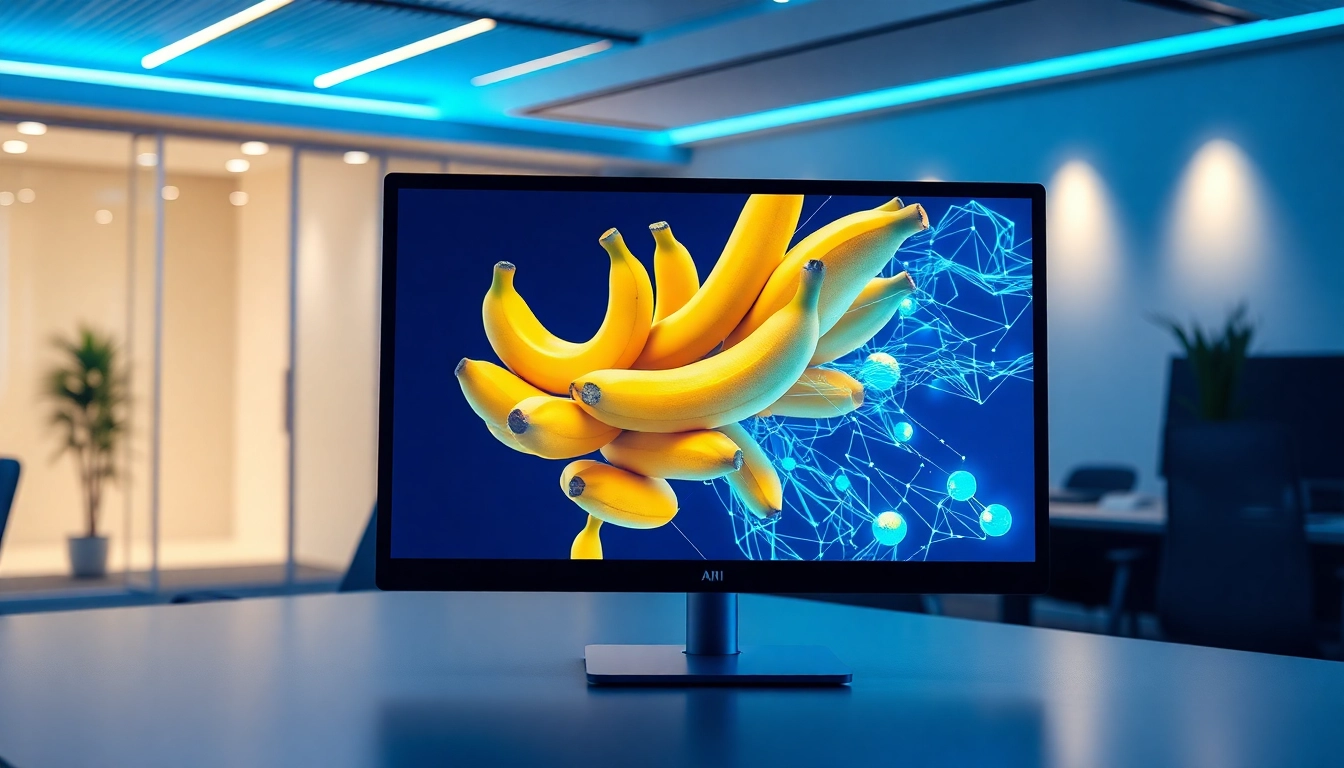Introduction to Nano Banana AI: A New Paradigm in Image Editing
In the rapidly evolving landscape of artificial intelligence and digital creativity, a groundbreaking innovation has emerged that promises to redefine how we approach image editing. At the forefront of this revolution is nano banana — an AI-powered image editor that claims to outperform all existing tools through unparalleled “advanced reasoning capabilities.” Unlike traditional image manipulation software that relies on basic pattern recognition or superficial edits, Nano Banana AI positions itself as a truly intelligent system capable of understanding images at a deep, contextual level.
This revolutionary platform is not merely about generating visually appealing images but about mimicking human-like comprehension of visual information. It aims to combine deep contextual understanding, perfect consistency, 3D spatial awareness, and logical reasoning into one seamless interface. As a result, Nano Banana AI is being heralded as the most advanced AI image editing tool available today, promising to elevate both casual creators and large enterprises into a new era of digital artistry.
What Sets Nano Banana Apart: Advanced Reasoning and Contextual Understanding
While many AI image editors on the market claim to provide quick fixes or stylistic transformations, Nano Banana AI distinguishes itself through its core technological innovation: advanced reasoning capabilities. This is not just about replacing backgrounds or adjusting colors; it’s about understanding what the user truly wants and why, at a fundamental level.
For example, traditional tools like Flux Kontext or Gemini 2.0 Flash offer straightforward edits—such as resizing, cropping, or basic object removal—often resulting in inconsistent or unnatural outcomes. Nano Banana AI, however, leverages sophisticated algorithms that analyze the entire image context, including spatial relationships, lighting conditions, and semantic content. This allows it to perform complex edits that maintain realism and coherence, even in intricate scenarios.
Imagine editing a scene with multiple objects, shadows, and nuanced lighting. Nano Banana AI’s reasoning engine can interpret the scene’s depth and spatial arrangements, ensuring that any modifications—be it changing an object’s position or adjusting textures—align perfectly with the scene’s natural perspective. This deep understanding makes Nano Banana AI a paradigm shift, transforming image editing from a cosmetic task into a genuine act of visual cognition.
Comparing Nano Banana with Competitors: Flux Kontext, Gemini 2.0, and More
Flux Kontext and Gemini 2.0: Basic vs. Advanced
Tools like Flux Kontext and Gemini 2.0 Flash have gained popularity for their quick and easy image manipulation features. They excel at basic edits such as color adjustments, simple object removals, or style transfers, making them suitable for casual users or quick fixes. However, their limitations become evident when faced with complex scenes or high-precision editing tasks.
Flux Kontext, for example, primarily focuses on style transfer and superficial adjustments, often producing inconsistent results when dealing with detailed backgrounds or multiple objects. Gemini 2.0, while offering some logical reasoning, still struggles with maintaining spatial consistency across complex edits. Their accuracy rates hover around 20-70%, which, depending on the task, can result in unsatisfactory outcomes.
Nano Banana’s Superior Performance
In stark contrast, Nano Banana AI claims to achieve accuracy levels of 95-99%, a significant leap forward. Its ability to comprehend the entire image context enables it to perform precise, coherent edits that other tools simply cannot match. Whether it’s swapping backgrounds seamlessly, maintaining consistent object positioning, or understanding 3D spatial relationships, Nano Banana AI excels where others falter.
Real-World Implications
This advanced capability translates into tangible benefits across industries. For digital artists, it means fewer hours spent fixing artifacts or unnatural transitions. For marketing teams and advertisers, it ensures high-quality, consistent visuals that resonate with audiences. For large enterprises, Nano Banana AI’s ability to handle complex, multi-layered scenes with accuracy can streamline workflows and reduce costs associated with manual editing and correction.
Deep Dive into Features: 3D Spatial Awareness, Consistency, and Logical Reasoning
3D Spatial Awareness
One of Nano Banana AI’s most impressive features is its 3D spatial awareness. Unlike typical 2D editors that interpret images flatly, Nano Banana understands the depth and spatial relationships within a scene. This allows it to perform perspective-correct edits, such as adjusting the angle of objects, removing or adding elements without disrupting the scene’s realism, and maintaining consistent lighting and shadows.
For instance, if a user wants to replace the background of a photo taken at an angle, Nano Banana’s 3D understanding ensures that the new background aligns perfectly with the foreground’s perspective. This spatial intelligence is a game-changer for photographers, videographers, and digital creators seeking photorealistic results.
Maintaining Perfect Consistency
Consistency is often a challenge in AI-driven image editing. Traditional tools might produce mismatched colors, inconsistent object sizes, or unnatural transitions. Nano Banana AI addresses this by employing advanced algorithms that remember and replicate styles, textures, and spatial relationships throughout the editing process.
For example, when editing multiple images for a campaign, Nano Banana can apply consistent color grading and object positioning, ensuring brand uniformity. This level of precision reduces the need for manual corrections and accelerates production timelines.
Logical Reasoning and Contextual Comprehension
The core of Nano Banana’s superiority lies in its ability to reason logically about images. It doesn’t just recognize patterns; it understands the purpose behind edits. This means it can interpret complex instructions such as “make the person look taller without distorting the background” or “replace the sky while keeping the foreground intact” with remarkable accuracy.
This reasoning capability enables the AI to handle ambiguous or multi-step tasks, adapting dynamically to user inputs and maintaining the integrity of the original scene. Such intelligence echoes human visual cognition, setting Nano Banana apart from simpler, pattern-based AI tools.
Target Audience and Use Cases: From Casual Creators to Large Enterprises
Casual Creators and Hobbyists
For everyday users and hobbyists, Nano Banana AI offers an intuitive interface that simplifies complex editing tasks. Whether it’s enhancing personal photos, creating social media content, or experimenting with artistic ideas, casual creators benefit from the platform’s intelligent suggestions and high-quality results.
Professional Photographers and Designers
Professionals demand precision, consistency, and speed. Nano Banana AI’s advanced reasoning allows photographers and designers to perform complex edits—such as compositing, retouching, and scene reconstruction—with minimal manual intervention. This not only saves time but also elevates the quality of finished work.
Commercial and Enterprise Applications
Large organizations can leverage Nano Banana AI for high-volume content creation, advertising campaigns, virtual staging, and product visualization. Its ability to handle large datasets, maintain brand consistency, and perform complex scene edits makes it an indispensable asset for marketing agencies, e-commerce platforms, and media companies.
Pricing and Value Proposition: Why Nano Banana’s Performance Justifies Investment
Understanding the platform’s pricing structure is essential for evaluating its value. Nano Banana AI offers three tiers: starting at $29/month, mid-tier at $49/month, and premium at $79/month, with an enterprise option tailored for large-scale needs. Despite the higher cost compared to basic editing tools, the platform’s advanced features and superior accuracy justify the investment for many users.
For casual creators, the entry-level plan provides access to core features with impressive results. For professionals and enterprises, higher-tier plans unlock additional capabilities like batch processing, priority support, and custom integrations. The platform’s claim of achieving 95-99% accuracy—compared to the 20-70% typical of competitors—means fewer retries, less manual correction, and faster project turnaround times, translating into cost savings and increased productivity.
The Ethical and Creative Implications of Intelligent AI in Visual Arts
The rise of highly intelligent AI image editors like Nano Banana raises important ethical questions and creative considerations. On one hand, these tools democratize access to professional-quality editing, empowering artists, marketers, and hobbyists alike. They elevate the quality of digital content, enabling more expressive and realistic visuals.
On the other hand, concerns about authenticity, copyright, and manipulation surface as AI becomes capable of producing hyper-realistic images and scenes that may blur the line between reality and fiction. Responsible use and transparency are crucial to ensure that AI serves as a tool for creativity rather than deception.
Furthermore, the development of AI that can “think” about images prompts a reevaluation of artistic processes. Creators may find new ways to collaborate with AI, using its reasoning capabilities to inspire novel visual concepts or to automate tedious tasks, freeing up human ingenuity for more conceptual work.
Future Outlook: How Nano Banana AI Will Shape Digital Creativity
The trajectory of Nano Banana AI suggests a future where AI-driven image editing becomes more intuitive, accurate, and integrated into various creative workflows. As the technology matures, we can expect enhancements such as real-time scene understanding, advanced 3D editing, and even more refined logical reasoning that mimics human cognitive processes.
In addition, integration with augmented reality , virtual reality , and other immersive technologies will open new vistas for digital storytelling, gaming, and virtual production. Nano Banana AI’s emphasis on understanding context and reasoning positions it as a foundational tool in the next generation of creative software.
Moreover, as the platform evolves, its potential applications could extend beyond image editing into areas like video synthesis, 3D modeling, and interactive virtual environments, further blurring the boundaries between human creativity and AI intelligence.
Conclusion: Embracing the Next Generation of AI Image Editing
In summary, Nano Banana AI represents a monumental leap forward in the realm of artificial intelligence and visual arts. Its ability to combine deep contextual understanding, logical reasoning, and perfect consistency sets it apart from all existing tools, making it not just an image editor but a true partner in creative expression. Whether you are a casual user, a professional artist, or a large enterprise, the platform’s promise of superior performance—achieving up to 99% accuracy—justifies its position as a paradigm shift in digital imaging.
As AI continues to advance, platforms like Nano Banana AI will likely become the standard bearers of intelligent, human-like visual understanding. By harnessing this technology, creators can push the boundaries of what’s possible, producing stunning, realistic images with unprecedented ease and precision. For those ready to step into the future of visual creativity, exploring ai nano banana is an essential first step toward mastering the next generation of AI-powered image editing.









